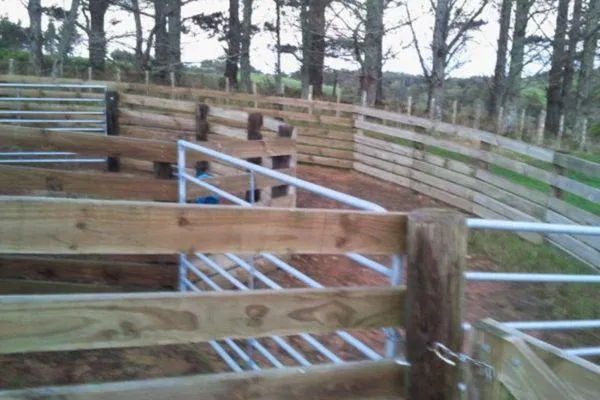
Yard Basics
If you are going to have livestock on your lifestyle block - you'll need pens or stockyards. Stock handling facilities aren't something that belongs on the "would be nice to have" list, they're essential. You'll need them to deal with sick animals, drenching, ear tagging animals if they're going to move off your property, mandatory TB testing when required … all the things that you can't do with an animal in the middle of a paddock.
Before you rush off and build a set if you don't need to use yards very often, and your neighbour has some - negotiate access to their yards. We used to do that at our last property before we built our own. Some etiquette for using neighbour's yards - check with them every time before you use them, clean up after yourself, repair any damage, leave gates as you found them, and drop a thank you in after every use (bottle of wine, box of beer, chocolates). A little gift goes a long way - and believe me - it's cheaper than building your own yards if you're only using them 3 or 4 times a year.
If you have to build your own, the good news is that yards don't have to be big, flash, or expensive. They do however need to be safe for you and the animals. Getting it right isn't that hard - it just takes a little thought.
If you're not planning on trucking animals off your property - your yards don't need to include a loading ramp. If you're only likely to truck 1 or 2 heads away a year - the cost of building a ramp is really hard to justify.
There is always the option of portable steel yards. Some people like them, some hate them - but they are a practical solution worth considering on a small block. You can shift them if you need to, take them with you if you move, or sell them if you decide to get rid of all your animals.
There is no perfect or completely safe set of yards, but there are a few simple tips worth following:
If you are building new yards - it doesn't cost any more to build yards that work well - the secret is getting the dimensions and the design right
If you are building new yards - don't make them up as you go along, get professional advice, put plans on paper, double-check dimensions, measure twice - cut once
If you already have a set of yards that aren't working well - get some professional advice on what needs changing - from a fencing contractor, your vet, or a stock agent
Don't skimp on materials, 100x25 might be OK for sheep, but 150x50 is the minimum for cattle-yard rails
Circular or semi-circular yards are very effective, a dream to work in, and can easily be increased in size to cope with larger herds
Build yards on level ground or slightly uphill - cattle resist moving downhill
Make sure your yards are well-drained - spend 5 minutes in winter in knee-deep mud in a pen with cattle to appreciate why drainage is so important. If your budget will allow it, put down metal, 100-150mm thick with weedmat under it to stop it from sinking into the mud
If you're building a loading ramp as part of your yards - allow for a stock truck actually being able to back onto the ramp
Build the loading ramp with a slight fall in the ground towards it - so the stock truck can roll back into it - rather than having to power uphill in reverse into it (crunch!)
Gates should swing freely and preferably have self-closing latches so you don't have to put your arms through gaps trying to hook a latch. If cattle push against the gate while you're hooking a latch or your arm is through it … you could break an arm or lose a finger
Reverse or pin gudgeons so that animals can't lift gates off hinges
20mm ply makes brilliant personnel or race gates in stockyards - double up 2 sheets cut to size and bolt together with 600mm galvanized hinge straps - you get a 40mm thick near-indestructible solid gate
The race and head bail should give the appearance of a clear view to open space or other cattle beyond - which will encourage cattle to move freely along the race or shute
The design of the pen leading to the head bail, crush, or loading ramp is important for good flow. With solid sides to the pen and no visual distractions, cattle will think the exit is the only escape route
Board up corners in pens to eliminate cattle bunching or facing away from you. Narrow pens allow you to put pressure on cattle. Cattle can avoid you more easily in large pens
Make sure there are plenty of access ways and emergency escape gaps between pens
Don't underestimate the speed, reach, or accuracy that cattle can kick with. The safest places to stand are either well back or right in close. Always wear steel-capped boots in the yards
Always have an escape route planned when you get into a pen with cattle
"Before You Start Fencing" is a practical guide packed with a lifetime of experience, offering essential tips and advice to help you plan and manage fencing projects with confidence.

